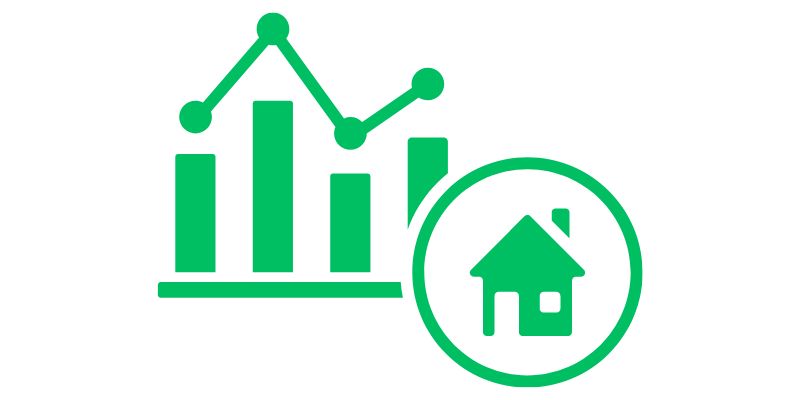In mid-2024, the New Zealand property market is expected to experience changes with new borrowing limits based on your earnings.
The new debt to income ratio regulations aim to stabilise property prices and align them more closely with wages, potentially reshaping your ability to secure large property loans.
The proposed debt to income (DTI) cap will determine the maximum amount you can borrow, typically up to 6 times your yearly income for residential properties and 7 times for investment properties.
This means if you earn 100,00 a year, you could be limited to borrowing up to 600,000, inclusive of all debts.
This move aims to promote financial health and stability. It prevents over-leveraging by maintaining a manageable ratio between your earnings and debts.
When it comes to lending, understanding debt to income ratios helps you set realistic borrowing expectations. So, let’s explore debt to income ratio’s further and what this means for borrowers in 2024.
Table of Contents
What is Debt to Income Ratio?

Debt to income (DTI) ratio is a financial term used by lenders to gauge your financial stability before they decide on offering you a loan. It is the relationship between what you owe and what you earn — a balance between your debt and income.
The DTI ratio helps lenders assess your ability to manage monthly payments and repay debts.
It’s calculated by dividing your total monthly debts (like car loans, credit card payments, and potential mortgage payments) by your monthly income before taxes.
Example:
If you earn 500 a month, and have monthly debt commitments (like credit card payments, existing loans, and other financial obligations) totaling 2000, your debt to income ration would be 40%.
Here is the formula:
The DTI (Debt-to-Income) ratio is calculated using the following formula:

Why Debt to Income Ratios Matter
A higher DTI ratio indicates that a person has less financial wiggle room to handle unexpected financial problems, like a loss of income or a rise in interest rates. This could increase the risk of credit losses for banks, especially during economic downturns.
How DTI Affects the Economy
Households with high DTI ratios might cut back on spending if they face financial shocks, even if they can still afford their mortgage. This reduced spending can affect the broader economy, as less money is circulating.
What is a Good Debt to Income Ratio for Mortgages in New Zealand?

Lenders use your debt to income ratio to determine the risk associated with offering you credit. A lower DTI ratio shows you’re more likely to manage your monthly debt payments alongside your living expenses.
Maintaining a low DTI ratio can help you secure better borrowing terms.
Here are the ideal debt to income ratios as percentages:
- Healthy DTI: 35% or less indicates a manageable debt load.
- Cautionary DTI: 36% to 49% could be problematic for some lenders.
- High DTI: 50% or more could limit your borrowing options, though non-bank lenders may offer alternatives.
Here’s a simple DTI Ratio in a Table:
| Monthly Income | Monthly Debt | DTI Ratio (%) |
| $5,000 | $1,750 | 35% |
| $5,000 | $2,250 | 45% |
| $5,000 | $2,750 | 55% |
By maintaining a lower DTI ratio, you enhance your borrowing power, making it easier to qualify for loans and receive better terms.
Calculate your DTI ratio and consider ways to reduce it if necessary, such as paying down debts or increasing your income, before applying for major loans like a mortgage.
DTI Ratios for Refinancing Student Loans
If you’re considering refinancing your student loans, lenders will often look for a DTI ratio that’s on the lower end. This means you’ll likely need a ratio that demonstrates your debt is manageable compared to your income. While acceptable ratios can vary, lenders typically prefer a ratio below 50% for refinancing approvals.
Considering DTI for Debt Consolidation
Regarding debt consolidation, a lower debt to income ratio can be advantageous. It suggests you’re not overly reliant on borrowing and may handle a new consolidated loan responsibly. Each lender sets their own DTI limits, but a ratio under 36% is often regarded as favourable.
What to Do if You Have a High Debt to Income Ratio

The concept of a “high” DTI ratio isn’t fixed; it varies, but the Reserve Bank pays special attention to new mortgages where the DTI is over five (i.e. the loan amount is more than 5 times annual income).
This is similar to other countries like Ireland and the UK, where loan-to-income (LTI) limits are set to manage risks differently based on each country’s conditions.
If your DTI ratio is high, consider increasing your income, paying down existing debts, or saving for a larger deposit to improve your loan approval chances.
Rules like these will compel lenders to scrutinise monthly income against monthly debt obligations more closely—including mortgage repayments, existing debts, and any other recurring expenses —ensuring that the overall financial commitment does not exceed the set DTI limits.
Consider providing additional documentation that showcases your financial stability beyond your DTI ratio, like assets, savings, or investments.
Securing financing with a high DTI ratio can involve higher interest rates or stringent terms; hence, it’s essential to ensure the loan’s affordability over the long term.
At OneStop Financial Solutions, we have access to a range of non-bank loans to make it easier for those who don’t fit in the box of standing lending criteria.
I Want to Build a New Home – Will the DTI Ratio Affect Me?

If you’re eyeing off a newly constructed home or considering undertaking a building project of your own, you might breathe easier knowing recent debt to income limits typically won’t hold you back.
The motivation for this exception is to encourage new home construction, a move aimed at lessening the nation’s acute housing squeeze and boosting economic activity.
Here’s what you need to understand about how this could influence your financial plans:
- Borrowing Advantage: When purchasing or building a new property, you might qualify to borrow beyond the typical six or seven times your yearly earnings, a substantial edge over buying existing real estate.
- Investor’s Edge: This could spell significant opportunity if you’re a property investor with an eye on constructing a portfolio oriented towards new builds.
- Look to the Future: With these DTI and loan-to-value ratio (LVR) carve-outs, new builds could set you up favourably for growth in the coming years.
Be mindful, though, of the total investment puzzle:
- Construction Costs: It’s essential to keep tabs on building expenditures. Ensuring these figures stack up is fundamental to the profitability of your investment.
Newly built homes may be exempt from typical DTI limits, offering potential advantages for property investors focusing on new constructions.
This exemption aims to encourage new home builds to help alleviate housing shortages.
By understanding and managing your debt to income ratio, you can better prepare for these upcoming changes and enhance your financial health and borrowing capacity.
How the Debt to Income Ratio Changes May Affect the NZ Property Market

The introduction of DTI caps is intended to temper the rapid escalation in housing prices by limiting how much people can borrow relative to their income.
Although the common belief is that property pricing hinges on supply versus demand, it’s essential to recognise that in fact, the availability and access to credit is a major force driving property values.
This deliberate move aims to stabilise real estate affordability over the long haul and avert the kind of abrupt escalation in housing costs experienced in previous times.
This could lead to more sustainable growth in property values and prevent the kind of speculative bubbles that have made housing unaffordable for many Kiwis.
Impact for Property Investors
If you’re contemplating the development of a rental property portfolio with new construction, there’s some promising news.
Exemptions to debt to income and loan to value ratio (LVR) regulations for new builds could position you for considerable growth in the years ahead.
Considerations for Your Property Investment Strategy:
- Construction Costs: While new builds offer exemptions, it’s crucial to monitor build expenses. Investments should be financially sound, not just fashionable.
- Economic Viability: Ensure the numbers add up. Your venture should yield more than it costs.
- Regulatory Perks: Leverage DTI and LVR exemptions to gain a competitive edge.
- Market Demand: Align your investments with what’s needed in the market. Aim for cost-effective, small-scale developments.
Understanding when and how these exemptions apply is essential for a strategic approach to property investment.
Long-Term Considerations
While the DTI regulations aim to stabilise the housing market, they also require buyers and investors to be more mindful of their financial health.
Maintaining a low DTI ratio not only helps in securing loans but also ensures that you are not over-leveraged, reducing financial stress and increasing economic stability.
Statistics on Debt to Income Ratios from the Reserve Bank NZ

Here are the key points from the Reserve Bank of New Zealand’s report on debt to income for December 2023:
- Total Mortgage Commitments: The total amount of new mortgages taken out in the last quarter of 2023 was 17.6 billion, an increase from 16 billion in the previous quarter and slighly up from $16.8 billion in the same period in 2022.
- Number of Mortgages: The number of new mortgages issued in Q4 2023 rose to 48,453, which is a 5.1% increase compared to the same period in 2022.
- High DTI Ratios: In December 2023, 29.6% of all new mortgage commitments had a DTI ratio greater than 5, which is the lowest percentage since records began. This suggests that fewer people are taking on mortgages that are more than five times their annual income.
- First-Time Home Buyers: For first-time home buyers, the proportion of mortgages where the loan is more than five times the buyer’s income also dropped to 24% from 35.3% the previous year, marking the lowest since this data started being tracked.
- Investment Properties: For mortgages tied to investment properties, the proportion with a DTI greater than 5 was also at its lowest in December 2023, standing at 45.2%.
- Owner Occupiers: The share of mortgages with a DTI greater than 5 for owner-occupiers without investment properties increased slightly from 21.1% in September 2023 to 22.4% in December 2023.
- Extreme DTI Ratios: The percentage of all new mortgages with a DTI ratio greater than 7 was 6.1% in December 2023, up from a record low of 5.2% in September 2023.
- Income Trends: The average gross income for first home buyers was
206.6K.
- Lending to High DTI and High LVR Borrowers: The proportion of first home buyers with both a DTI greater than 5 and a loan-to-value ratio (LVR) greater than 80% decreased to 6.9% from 11.2% the previous year. For other owner-occupiers without investment properties, this figure also dropped from 1.9% to 0.9%.
This summary shows that while more people are getting mortgages, the proportion of those with high debt relative to their income is decreasing, indicating potentially healthier financial planning or stricter lending standards.
Strategies for Dealing with DTI Regulation Changes
As New Zealand braces for stricter DTI regulations, it’s important to devise strategies that can help maintain or improve your borrowing power under the new rules:
- Enhance Income: Increasing your income can significantly lower your DTI ratio. Consider opportunities for salary raises, secondary jobs, or freelance work.
- Reduce Debts: Focus on paying down debts and minimising new debt acquisitions. This can improve your DTI ratio and enhance your eligibility for better loan terms.
- Save a Larger Deposit: Saving for a larger deposit reduces the amount you need to borrow and demonstrates financial responsibility to lenders, which might be particularly persuasive under stricter DTI caps. If you’re a first home buyer, our brokers can help you get the most out of your KiwiSaver and other available grants.
- Explore Exemptions: Pay attention to exemptions, such as those for new construction, which may allow you to borrow beyond the usual limits. If you’re looking at investment opportunities, targeting new builds might offer additional leverage.
- Alternative Financing: Consider non-bank lenders who may have more flexible lending criteria if traditional banks cannot accommodate your needs due to high DTI ratios. These lenders often provide solutions tailored to those with unique financial situations.
Conclusion
Understanding and preparing for the impact of debt to income ratios is more important than ever as New Zealand moves towards implementing these financial controls.
By managing your finances wisely, exploring all available options, and planning strategically, you can navigate the changing landscape effectively, ensuring your financial actions align with both personal goals and regulatory requirements.


